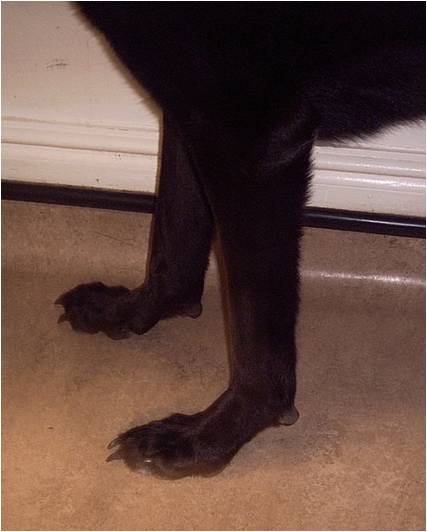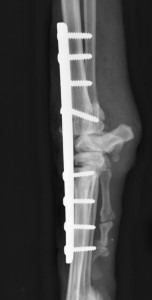Our pets can be adventurous. With such activity, accidents are bound to happen. Sometimes the carpus (wrist) is injured. Occasionally, trauma to this region necessitates permanent immobilization – such a procedure is called an arthrodesis. This week I wanted to share some information about this relatively common surgery to help increase awareness. Happy reading!

Carpal Arthrodesis – What is it?
Arthrodesis is the medical term that describes a surgical procedure used to fuse bones of a joint so mobility is eliminated. The carpus or wrist has many bones, and they’re arranged in two rows. This arrangement creates three distinct joints:
- Antebrachiocarpal joint – closest to the body
- Middle carpal joint – middle joint
- Carpometacarpal joint – farthest from the body

A veterinarian will obtain radiographs (x-rays) of the carpus before surgery. These are essential for proper surgical planning. The arthrodesis procedure is performed with a pet under general anesthesia. All remaining cartilage within the affected joints is removed. Subsequently, bone graft material is placed in the joints to promote fusion. Then the joints are secured in place, typically with a bone plate and screws. Radiographs are reevaluated immediately post-operatively to ensure proper implant placement. The orthopedic implants remain in place until the joints successfully fuse at a functional angle.
Carpal Arthrodesis – When is it recommended?
When standing, the normal angle of the carpus is 140°-180° and 160°-180° in dogs and cats, respectively. During a normal stride, each thoracic limb carries ~30% of a pet’s weight. During running, jumping, and aggressive activity, carpal trauma is absolutely possible. A veterinarian may recommend arthrodesis if a pet sustains a meaningful injury to this region. Such injuries include:
- Ligament damage that leads to joint instability
- Carpal joint (sub)luxations or dislocations
- Fractures of carpal bones

It’s important to note injury to the carpus may be acute or chronic and repetitive. Arthrodesis is considered a salvage procedure. This means the injury can’t be adequately controlled by other methods, and we are striving to provide meaningful pain relief.
There are two types of carpal arthrodesis procedures: partial carpal arthrodesis and pancarpal arthrodesis. During partial carpal arthrodesis, the middle carpal and carpometacarpal joints are fused. All three carpal joints are fused during a pancarpal arthrodesis procedure. Pet parents will likely find it helpful to consult with a board-certified veterinary surgeon to discuss the benefits and risks of each surgery.

Carpal Arthrodesis – What are the potential complications?
As with any surgical procedure, complications are possible. Major possible complications of carpal arthrodesis are:
- Failure of joint fusion
- Orthopedic implant breakage
- Incision complications (i.e.: infection, dehiscence/breakdown)
- Nerve damage
- Abnormal leg alignment
- Pressure sores from temporary cast/splint
Rare complications include chronic infections associated with the orthopedic implants, tumor development at the surgical site, and cold sensitivity. Without complications, joint fusion following carpal arthrodesis occurs within 3-4 months. Marked exercise restriction is of paramount importance during this time. Most dogs can resume controlled activity after 3 months and return to full activity in six months. Premature return to activity often leads to implant failure, the need for another surgery, and additional cost to families.
The take-away message about carpal arthrodesis in pets…
Carpal or wrist injuries are relatively common in dogs and cats. Often such injuries necessitate a veterinarian fusing the joints in the region to immobilize them and reduce patient discomfort. This joint immobilization surgery is called carpal arthrodesis. Without appropriate post-operative care, the vast majority of pets are much more comfortable and lead happy lives.
To find a board-certified veterinary surgeon, please visit the American College of Veterinary Surgeons.
Wishing you wet-nosed kisses,

